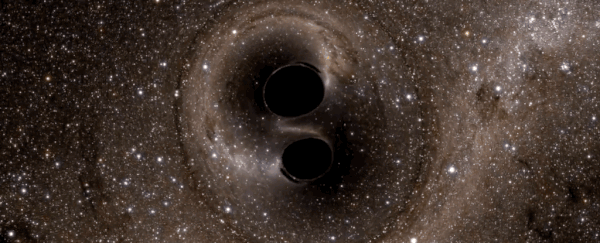Thanks to recent groundbreaking observations, we now know that two colliding black holes produce gravitational waves - ripples in the fabric of space-time. It was thought that the waveform (or shape) of the signal produced by these events was too complex to be calculated, but now a theoretical astrophysicist has done just that.
In a new paper, Sean McWilliams from West Virginia University has detailed an exact mathematical formula for the waveforms produced by black holes of varying mass and spin.
It's a result that will help produce more accurate waveforms for post-merger analysis, as well as shed light on the dynamics of black hole collisions.
As we know from studying multiple black hole collisions, since that first Universe-shaking gravitational wave discovery in September 2015, the event occurs in several stages.
First, as two black holes in a binary system start orbiting inward towards each other, closer and closer on an inexorable collision course, they start producing faster and faster gravitational waves, spiralling out through the Universe.
When the two black holes collide, the waves hit a crescendo. Then they gradually subside as the black hole jiggles into its new mass. These three stages are called the inspiral, the merger, and the ringdown.
Black holes, as we all know, are the most gravitationally intense objects in the Universe. They twist and warp and drag the space-time in their immediate vicinity, which makes the mathematical analysis of these events rather complex, to say the least.
Throw two black holes together, and you end up with exponential space-time warping, which plops the mathematics firmly into nonlinear territory - that is, the extremely hard basket.
So scientists interpreted the signals detected by gravitational wave interferometers (such as LIGO) by comparing them to computer simulations based on numerical relativity. This works pretty well, but it does have some limitations.
According to Science, McWilliams's solution has to do with distances around the black hole. We all know the distance at which light can no longer achieve escape velocity, the point of no return. That's the event horizon.
Within 1.5 times the event horizon's distance, the black hole's gravity is so strong that light bends, the photons forced to travel in orbits. That's called the photon sphere.
And at about three times the event horizon's distance is the closest matter can come to the black hole while maintaining a stable circular orbit. That's called the Innermost stable circular orbit, or ISCO.
Previous attempts to formulate the waveform of a black hole collision had run into a problem with the ISCO. Within that region, when defined by mathematics, the bodies stop spiralling inward, instead falling into a stable orbit.
Obviously, that's not what happens in the real world, so something was not quite working out. McWilliams worked around it by skipping that part and going straight to the black hole. Then he calculated the path of a test mass spiralling in towards the black hole, according to general relativity.
This allowed him to calculate the waveform inward from the ISCO. Within the photon sphere, the mass becomes untraceable because of the strange physics, but McWilliams determined that this could be safely ignored - because nothing can escape from that region to affect the gravitational waves rippling outward across space.
The resulting formulas produced accurate waveforms for detected mergers, surprisingly consistent with the numerical relativity results obtained so far.
"I'll be honest," McWilliams told Science, "I was rather floored how well it agrees with the results of numerical relativity."
Obviously it's too early to replace numerical relativity, but with at least one gravitational wave event now being detected on a weekly basis, there will be plenty of observations to put McWilliams's formulae through their paces.
His paper has been accepted into Physical Review Letters, and is available on arXiv.
